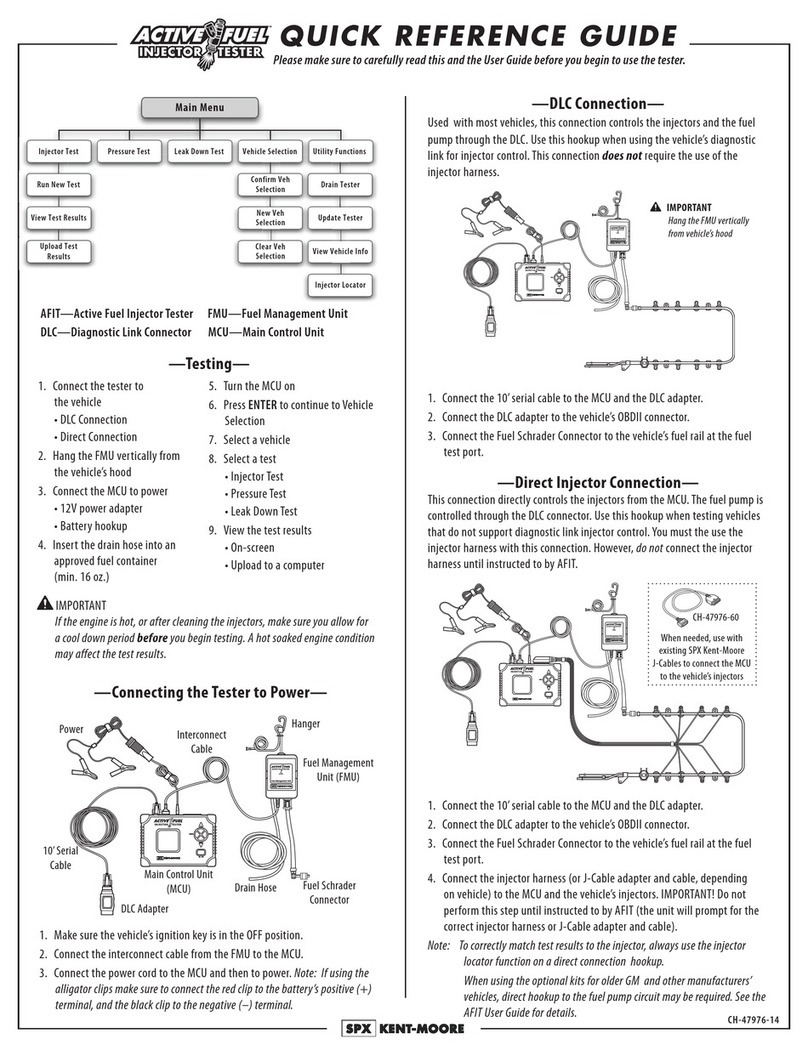(Continued)
(Continued)
2
J-39916 Delco Audio System Diagnostic Kit
The Delco Audio System Diagnostic Kit was developed to diagnose the Delco Active
Audio System and Delco Audio Systems with a pre-recorded diagnostic cassette tape or
compactdisc(CD).RefertotheappropriateGMservicemanualforspecificinstructions.
Instruction Book Contents:
A. CassettePlayerPreparation
B. CassetteTapeDiagnostics
C. Compact Disc Diagnostics
D. ServicePartsList
A. CASSETTE PLAYER PREPARATION
(This preparation will ensure proper diagnosis)
Inspection of the player must take place before using the cleaning and diagnostic
cassettes. Using a light source, carry out a visual check through the cassette entry flap
and ensure that there is not debris inside the player and that tape is not wrapped around
the capstan.
Beforeproceedingwiththediagnosticcassette,thetonehead,pinchwheel(s)and
capstan(s) must be cleaned. To do this, use the head cleaning cassette as follows:
1. Puttwo(2)dropsofthecleaningsolutiononeachfeltpad.
2. Insert the cleaning cassette into the cassette deck and play for 20 seconds.
(Press“play”buttonifthedeckdoesnotstartautomatically.Forautoreverse
decks,engagethe“autoreverse”featureandcleanforanother20seconds.)
3. Removetheheadcleaningcassette.Nowallow2-3minutesofdryingtime
before proceeding.
NOTE:Itisrecommendedthattheheadcleaningcassetteisusedevery
10 to 15 hours of play time.
Replacecleaningcartridges
when the felt pads look dirty.
The diagnostic cassette can now be
played and will highlight problems
with audio reproduction.
Auto
reverse
tape drive
Tape head
Capstan
Pinchroller
7
Always compare the front speakers to front, and rear speakers to rear. Don’t compare the
front speaker to rear speaker because they could be different speakers or their mounting
environment could cause them to sound different.
Thethreebasictonesusedtotestandevaluatebaselevelspeakers,orothercomplex
speaker systems are a bass (50 Hz sine) tone, mid (500 Hz warble) tone,
a tweeter (9kHz spectral) tone. The combination tone is a blend of the above
three tones.
BASS SPEAKER TEST - (50 Hz sine)
The 50 Hz tone is used to evaluate the bass response of an audio system. This tone is
also helpful in evaluating audio systems which have separate subwoofer amplifiers and
speakers.
MID-RANGE SPEAKER TEST - (500 Hz warble tone)
The 500 Hz warble tone is used for the evaluation of mid range speaker response. This
tone is qualified as a warble tone because it has different audio characteristics than a sine
tone. This tone produces a warble sound. At these mid-range frequencies, it is better to
use a warble tone than a sine wave because the location of warble tone source, such as
a speaker, is easier to identify. A normal sine tone can set up a standing wave within a
vehicle which can make it difficult to determine its source location.
TWEETER TEST - (9kHz spectral tone)
The 9kHz spectral tone is used for tweeter or high frequency evaluation. This tone sounds
likeagroupofcricketschirping.Thistypeoftoneisusedfortworeasons.One,much
like the warble tone, it is easy to locate its source, and two, this type of tone is easier to
identify for those people with high end hearing loss problems.
ALL SPEAKER TEST - (Combination tone)
With the combination tone, you will be able to quickly diagnose overall audio performance
in a vehicle. This tone can be used for numerous audio problems, such as distorted or
nosoundfromspeakerorspeakers.Listeningtothecombinationtone,youshouldbe
able to hear three distinct sounds. A low pitch steady tone of 50 Hz, a medium frequency
warbling tone of 500 Hz, and a high frequency hiss or cricket type of sound about 9kHz.
Concentrateontheappropriateelementofthetestsignal;Low,Medium,orHighasyou
listen to the different speaker locations by means of the fade and balance controls. This
tonecanbeanexcellentsignaltouseinthediagnosisofcoaxialspeakers.For example,
ifacoaxialspeakerisnotfunctioningproperly,adirectcomparisonoftherighttoleft
speaker, or visa versa, can determine if the tweeter or woofer in the speaker assembly is
inoperative.


























